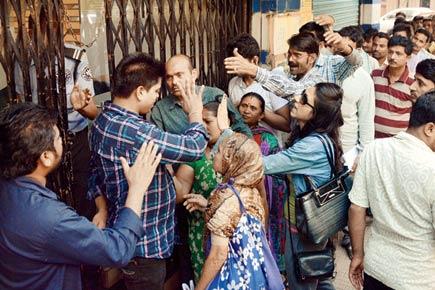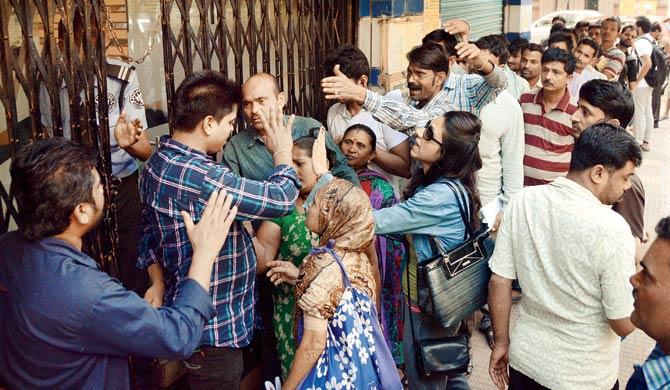Faced with weak odds in the UP polls due to poor handling of caste issues, BJP may now launch a communally polarising campaign there


There is much noise and several unreliable surveys to tell us that people are happy with demonetisation even though a visit to a local branch will show you the dark side of civic community. File pic
ADVERTISEMENT
 Prime Minister Narendra Modi is believed to have told the two Muslims in his council of ministers not to campaign in UP for the state assembly election, due by April 2017. It is obviously a high-stake election for Modi and BJP president Amit Shah. In 2014, they took 73 (two came with an ally) of the state’s 80 parliamentary seats. They want to seize control in the state government because winning a second term in 2019 depends on UP delivering a sizable chunk of seats. Ground reports are varied: the BJP looks strongest in eastern UP, and weakest in western UP, where Jats are angry over the heavy hand with which their reservations protest in Haryana was handled.
Prime Minister Narendra Modi is believed to have told the two Muslims in his council of ministers not to campaign in UP for the state assembly election, due by April 2017. It is obviously a high-stake election for Modi and BJP president Amit Shah. In 2014, they took 73 (two came with an ally) of the state’s 80 parliamentary seats. They want to seize control in the state government because winning a second term in 2019 depends on UP delivering a sizable chunk of seats. Ground reports are varied: the BJP looks strongest in eastern UP, and weakest in western UP, where Jats are angry over the heavy hand with which their reservations protest in Haryana was handled.
Another momentary BJP weakness is the lack of a clear chief ministerial candidate. Current expectation is that Mayawati is a strong contender: Dalits are solidly behind her after the BJP’s self-goals in Gujarat, where anti-Dalit violence led to widespread protest, and at Hyderabad Central University, where student Rohith Vemula killed himself. Additionally, Muslims will vote surgically and in her favour because she has the best chance of beating the BJP, helped along by the ruling Samajwadi Party’s palace intrigue.
Added to the mix is the November 8 demonetisation of high-value currency notes that has disrupted life due to its poor implementation (17 amendments to rules in 17 days). Even diehard Modi supporters among NRIs say they’ve heard of ‘transitional chaos’ back home. Experts, analysts and politicians all seem to accept it as conventional wisdom that the rural voters are harder hit than urban Indians: besides the fact that early parts of every supply chain is almost wholly in cash, the mere fact that banks have, according to the Reserve Bank of India’s own statistics, double the number of customers per rural branch than urban branch, shows the more intense pain in the countryside — even if they are consuming less cash.
This is pertinent to UP because India’s largest state is not just among the poorest, but also least developed. It has little industrial development, which is why the politics of political patronage for contracts and jobs is so deeply entrenched there. Not just in its murky politics: cash is integral to almost every aspect of life. So while some folks in the tier-II and tier-III towns may be switching to mobile wallets in response to Modi’s call for a “cashless society”, they are just drops in the vast Gangetic bucket.
There is talk that the Pradhan Mantri Jan Dhan Yojana accounts, launched to broaden the banking base, have been used to launder money. To meet targets, bankers had opened accounts with Re 1 or Rs 2 in them. UP has the highest number of account holders, at 3.79 crore; since demonetisation, Rs 64,252.13 crore has been deposited in these accounts, according to what the government told Parliament on Friday. Per account, that comes to about Rs 17,000; some think this is a bribe that will hand the election to the BJP. More likely is that the unreturned old currency will be transferred as a dividend to government and then deposited in these accounts — enough to assuage rural voters.
That is in the future. Thus, Modi has told his Muslim ministers to stay clear of the UP election. This is a clear indication of what kind of campaign Amit Shah intends to conduct: a communally polarising one. It paid dividends for the BJP in 2014, a year after the riots in Muzaffarnagar. Obviously, the party feels this is the most effective way of overcoming Mayawati’s looming electoral advantages going into the campaign.
To this end, there has been much talk in Delhi’s power circles over the past couple of months that the surgical strike on the other side of the Line of Control (LoC) in Kashmir at the end of September, that India carried out in retaliation for the terrorist attack on the army camp in Uri in J&K, would be repeated just before the UP election. This is not a tall order: the situation at the LoC has continually deteriorated with soldiers and civilians coming under the other side’s unrelenting attack. But it is all just a slightly warmed-up version of the low-level hostility that serves the government’s purpose without the military retaliation getting out of hand.
It is difficult to say how much this will influence the state election even if it polarises voters. One, there is much noise and several unreliable surveys to tell us that people are happy with demonetisation even though a visit to a local branch will show you the dark side of civic community; and two, many voters would have already made up their mind. That will have no deterrent effect on the strongman’s showmanship, so ready yourselves for more zero-balance disruptive governance.
Senior journalist Aditya Sinha is a contributor to the recently published anthology House Spirit: Drinking in India. He tweets @autumnshade. Send your feedback to mailbag@mid-day.com
 Subscribe today by clicking the link and stay updated with the latest news!" Click here!
Subscribe today by clicking the link and stay updated with the latest news!" Click here!






